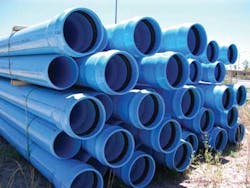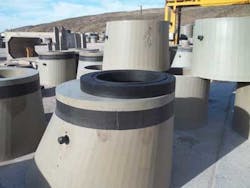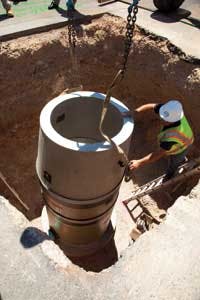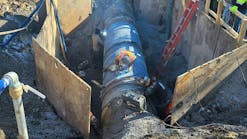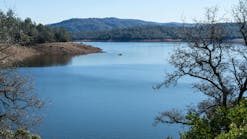Asset Management: Using Alternative Materials to Address Replacement Cost and Maintenance Concerns
By Gregory M. Baird
In the 21st century, water utility management professionals for both water and sewer systems strive to implement asset management programs in order to better manage their aging wet infrastructure.
In 2012, a Black and Veatch survey1 on the US water industry found that the top asset management issues were all financially driven, namely addressing aging water and sewer infrastructure, managing capital costs, funding or availability of capital, and energy costs. In 2013, a McGraw Hill Construction study, conducted in partnership with CH2M Hill,2 confirmed that 75% of utilities implementing asset management programs did so because of their concerns with aging infrastructure.
Major studies from the US Mayor's Water Council,3 the USEPA,4 the Congressional Budget Office,5 US Government Accountability Office,6 the American Water Works Association7 and others all conclude that the costs associated with US water and sewer infrastructure - for both replacement of aging systems and for new development driven by growth - is financially overwhelming, ranging from $1 trillion to $4 trillion over the next couple of decades.
The financial challenges faced by utility, asset and financial managers have intensified with the downturn of the world economy, tapped out rate payers, unstable credit markets, wide-scale downgrades and paralyzed project- and rate-approving authorities. Some consulting firms are responding by offering financial services. For example, MWH Global is an early adopter of wet infrastructure asset management practices worldwide. With its acquisition of Stepwise Utility Advisors in 2012, it has added the additional facet of providing financial and risk services to support infrastructure funding options and improved investment decision making.
Regardless of basic funding sources, existing rate charges for replacement projects, and developer fees for new growth projects, the primary goal is figuring out how to manage and reduce the costs of the infrastructure through its entire asset life. As a result, traditional paradigms are giving way to new technologies, products, and methodologies.
According to the USEPA, nearly 60% of the total price tag lies with the underground infrastructure. Many utilities understand this reality, which has driven wide acceptance of and advances in leak detection, condition assessment and infrastructure replacement planning efforts. A key asset management trend has emerged: new options in material selection and project delivery alternatives. These critical options offer change, which can be hard for a utility to accept. The benefit, however, is less maintenance and more cost savings, which ultimately protects the financial stability of the organization and its staff.
Alternative Pipe Materials
Change has spurred increased competition and innovation, which continues to help reduce costs for the utility and its rate payers. In the area of underground water and sewer pipes, for example, a wide variety of pipe materials can now be used to help address cost concerns. In fact, the current cost paradigm shift in pipe design applications has created a veritable "pipe war" as product lines battle for market share.
Modern hydraulic modeling software and improved water pressure operational knowledge has expanded the use of alternative pipe materials over the traditional ductile-iron-only option. For instance, utilities are realizing a cost savings of 30% to 70%8 in material costs by installing PVC in residential areas. In fact, home builder associations are beginning to urge municipalities to allow PVC to be installed in larger diameters in order to reduce the cost of new development.
While PVC and ductile iron are the most prominent types of pipe materials currently being installed in water distribution systems, there are other materials, like polyethylene and PVCO, each with unique characteristics for use in various conditions in water, sewer, storm and reuse applications. This offers a significant potential benefit to utilities if open procurement practices are updated so the utility can employ the use of different pipe materials suitable for various types of projects.
Key Considerations
When selecting a pipe material, key considerations include trench conditions, corrosion, temperature, safety requirements, and cost. Pipes are approved and tested by the American Society of Testing Materials (ASTM) and the American Water Works Association (AWWA), and many have the presence of the NSF designation on the pipe indicating that it was tested for compliance with one or more voluntary national standards and undergoes continual rigorous testing. Needless to say, these pipes are safe for their intended purpose. Likewise, these various pipes have been tested and demonstrate expected useful lives at over 100 years if properly installed.
Comprehensive studies on pipe performance, such as the "2012 US and Canada Water Main Break Study" by the Buried Infrastructure Laboratory of Utah State University,9 continue to help provide additional assistance on pipe evaluation and selection. While this study finds PVC to have the fewest main breaks, it is interesting to note one critical finding: the Canadian experience with PVC failures per 100 kilometers is nearly 76% below U.S. figures through proper inspection and installation.
Proper pipe knowledge, installation and inspections protect the public investment and avoid unnecessary and premature failures. No pipe material, however, is exempt from failure in the absence of proper design followed by adequate inspection. A poorly informed inspector, or one who has not been properly trained in the manufacture, inspection, handling, installation and testing of the type of pipe he or she is hired to inspect, is often worse than no inspection at all.
Controlling Corrosion
The two major C's - cost and corrosion - are predominant topics of discussion when it comes to underground infrastructure. Corrosion, not necessarily age, has frequently been the main culprit in iron pipe failures. In a 2004 report, corrosion experts NACE International found that the cost of corrosion in the US for all major infrastructure sectors is $276 billion - or 3.1% of the GDP. The direct costs of corrosion include:
- Cost of labor attributed to corrosion management activities
- Cost of equipment related to corrosion activities
- Loss of revenue due to disruption in supply or service
- Cost of reliability
- Cost of lost capital due to corrosion deterioration
The cost of corrosion in drinking water and sewer systems alone was stated in 2004 as $36 billion and has increased by some estimates to as much as $50 billion. Corrosion prevention methods and services include protective coating, corrosion-resistant alloys, corrosion inhibitors, engineered plastics and polymers, cathodic and anodic protection, and corrosion control services. NACE's goal is to increase the awareness of the effects and cost of corrosion while also building the awareness of the potential savings that can be reaped from preventative strategies. Nonetheless, non-corrosive materials must be a first-step consideration in a preventative strategy.
Sewer infrastructure, in particular, is exposed to highly corrosive and acidic environments, requiring continual maintenance and cleaning. Despite that level of care, sewer infrastructure still incurs a high frequency of deterioration and premature failures. Concrete is the most widely used construction material in wastewater collection and treatment systems. Unfortunately, concrete quickly erodes when subjected to significant corrosion.
Concrete sewer manholes are no exception. Placed every 200 to 400 feet for sewer maintenance activities, concrete manholes are often lined and relined with protective coatings and plastic liners. However, these processes are temporary and continue to raise the cost of the asset over time.
Polymer Manholes
While non-corrosive pipes have the benefit of extended performance, concrete manholes continue to pose a continual maintenance and cost drain due to corrosion. By contrast to concrete, polymer manholes, made of polyester resin, sand and aggregate, present a cost-effective replacement option.
Polymer manholes have no cement in the product. Hence, the corrosion commonly found in precast concrete manholes is not a concern. Limitations that exist in coated and lined manholes - cracking, damage, delaminated welding or lining containment - are eliminated.
The installation is similar to that of a traditional concrete manhole. The advantage of polymer products is that the high-strength material enables a thin wall design (and consequently lighter weight), which allows for easy handling, reduced labor, and lower freight and installation costs. Also, there is no need for the welding of linings or for coating the product, practices which only increase the installation difficulty, time and costs.
Polymer manholes adhere to the material properties specified in ASTM D6783 (Standard for Polymer Pipe). The high tensile strength of polymers also negates the added expense of reinforcing steel. Polymer manholes are cost effective even though the initial cost may be slightly higher - perhaps a couple hundred dollars over concrete epoxy-coated or PVC-lined manholes - but, by avoiding maintenance, relining and repair costs over the life of the manhole, the return on investment (ROI) is incredible. A polymer manhole can have a 50-year warranty and last 100 years or more in a corrosive environment, creating a common asset life for the pipe and the manhole together.
It's important to note that a change to procurement options may be needed to include sustainable polices such as life cycle cost considerations or a non-corrosive specification for polymer manholes. A polymer manhole replacement program over the next century will ensure both sustainability and lower sewer rates. The most cost-effective strategy to begin a sustainable replacement program is to start with a pilot program.
Growing public pressure for improved asset management practices and long-term planning to reduce overall risks and cost continues to increase. This pressure will, in turn, force the change necessary to capture current and future benefits in the areas of open procurement, material selection and asset management best practices. This type of change represents the continuing improvement process for utilities to achieve sustainable solutions that are both cost effective and affordable.WW
About the Author: Gregory M. Baird, CFO of Aging Water Infrastructure (AWI) Consulting (www.AgingWaterInfrastructure.org) and president of The Water Finance Research Foundation (www.WaterFinanceRF.org), is developing a one-stop information center for wet infrastructure while also directing efforts to establish an American public infrastructure–asset management association combining traditional disciplines with technology and finance. Baird is an experienced municipal finance officer and utility management professional, having consulted at the state, county and local levels of government. He has also served in the public sector working in California and as the CFO of Colorado's third largest water utility.
References
1. Strategic Directions in the U.S. Water Utility Industry, Black & Veatch, 2012.
2. Water Infrastructure Asset Management: Key Research Findings, McGraw-Hill Construction, 2013.
3. Trends in Local Government Expenditures on Public Water and Wastewater Services and Infrastructure: Past, Present and Future, The U.S. Conference of Mayors – Mayors Water Council, 2010.
4. "U.S. Water Infrastructure Needs & the Funding Gap," USEPA.
5. Future Investment in Drinking Water and Wastewater Infrastructure, Congressional Budget Office, 2002.
6. Clean Water Infrastructure: A Variety of Issues Need to Be Considered When Designing a Clean Water Trust Fund, U.S. Government Accountability Office, 2009.
7. Buried No Longer: Confronting America's Water Infrastructure Challenge, American Water Works Association, 2012.
8. "Pleasanton's Underground Infrastructure: Sustainability, Cost-Efficiency Through Better Materials Procurement Practices," Jennifer Hosterman, U.S. Conference of Mayors, May 2011.
9. Water Main Break Rates in the USA and Canada: A Comprehensive Study, Steven Folkman, Ph.D., PE, Utah State University Buried Structures Laboratory, April 2012.
WaterWorld Articles Archives
